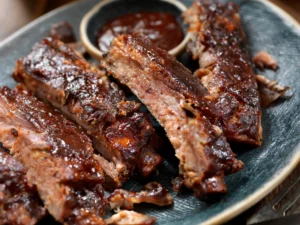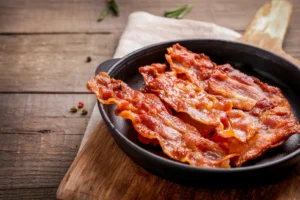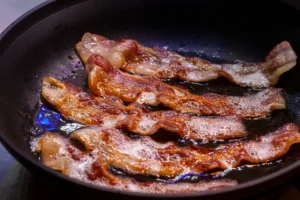Bacon, with its tantalizing aroma, crispy texture, and rich, smoky flavor, has become a beloved staple in kitchens around the world. This cured pork product has a history as rich as its taste, weaving through centuries of culinary evolution and cultural significance. From its ancient origins to modern-day bacon mania, this article explores the journey of bacon, its preparation methods, health aspects, and its versatile role in contemporary cuisine.
The Origins and History of Bacon
The origins of bacon can be traced back to ancient civilizations, where preserving meat was essential for survival. The practice of curing pork with salt dates back to around 1500 B.C. in China. As these techniques spread through trade and conquest, they were adopted and refined by various cultures, including the Romans, who called it “petaso.”
During the Middle Ages, bacon production became more sophisticated, especially in Europe. Pigs were a crucial part of medieval agriculture, providing not only meat but also lard for cooking and making soap. The term “bacon” itself comes from the Old High German word “bacho,” meaning “buttock” or “ham.” In England, bacon became a dietary staple, with different regions developing their unique curing methods.

The Process of Making Bacon
The process of making bacon involves curing pork, usually from the belly or back cuts of the pig. This curing can be done using a variety of methods:
- Dry Curing: The traditional method involves rubbing the pork with a mixture of salt, sugar, and spices, then allowing it to cure for several days to weeks. This method intensifies the flavor and creates a firmer texture.
- Wet Curing: Also known as brining, this method involves soaking the pork in a solution of salt, sugar, and water. Wet curing is faster than dry curing and often results in a slightly milder flavor.
- Smoking: After curing, the bacon is often smoked to add flavor and further preserve the meat. Different types of wood, such as hickory, apple wood, or maple, impart distinct flavors to the bacon.
The Rise of Bacon in Popular Culture
Bacon’s rise in popular culture is a testament to its universal appeal. In the United States, bacon gained significant popularity in the 20th century, becoming a quintessential breakfast item. The post-World War II era saw a boom in the American meat industry, making bacon more affordable and widely available.
In recent decades, bacon has transcended its traditional role as a breakfast side. The early 2000s marked the beginning of “bacon mania,” a cultural phenomenon where bacon became a trendy ingredient in a variety of dishes. From bacon-wrapped everything to bacon-flavored desserts and cocktails, the versatility of bacon has been celebrated by chefs and food enthusiasts alike.

The Health Aspects of Bacon
While bacon is undeniably delicious, it is also a topic of debate when it comes to health. Here are some key points to consider:
- Nutritional Content: Bacon is high in fat, particularly saturated fat, and contains cholesterol. A typical serving of bacon also provides protein, vitamins (like B vitamins), and minerals (such as zinc and iron).
- Health Risks: Regular consumption of processed meats, including bacon, has been linked to increased risks of certain health conditions, such as heart disease, cancer, and hypertension. This is due to the presence of nitrates, nitrites, and high levels of sodium.
- Moderation and Alternatives: To enjoy bacon as part of a balanced diet, moderation is key. There are also alternatives, such as turkey bacon or plant-based bacon, which offer a lower-fat or meat-free option.
Bacon in Modern Cuisine
Bacon’s versatility makes it a favorite ingredient in modern cuisine. Its unique combination of smoky, salty, and savory flavors enhances a wide range of dishes. Here are some popular ways bacon is used in contemporary cooking:
- Breakfast Dishes: Beyond the classic bacon and eggs, bacon is a key component in dishes like breakfast burritos, omelets, and pancakes with bacon bits.
- Salads and Appetizers: Crumbled bacon adds texture and flavor to salads, while bacon-wrapped appetizers, such as jalapeño poppers and scallops, are crowd-pleasers.
- Main Courses: Bacon can be found in pasta dishes, sandwiches, and burgers. It is also used to add depth to soups, stews, and casseroles.
- Desserts: The sweet and salty combination of bacon and sweets has gained popularity. Bacon-infused maple syrup, chocolate-covered bacon, and bacon cupcakes are just a few examples.
- Drinks: Bacon has even made its way into beverages, with bacon-infused bourbon and Bloody Mary cocktails becoming trendy choices.

Bacon Around the World
While bacon is often associated with American and British cuisine, it has a global presence, with each culture adding its own twist:
- Canada: Canadian bacon, also known as back bacon, is made from the pork loin and is leaner than American-style bacon. It is often found in breakfast dishes and as a pizza topping.
- Italy: Pancetta, an Italian cured meat, is similar to bacon but is not typically smoked. It is used in a variety of Italian dishes, including pasta carbonara and as a topping for pizzas.
- Germany: Speck is a type of German bacon that is dry-cured and often smoked. It is used in a variety of dishes, from hearty soups to traditional sauerkraut.
- Japan: In Japan, bacon is often used in fusion cuisine, such as bacon-wrapped sushi rolls or in ramen dishes.
- Korea: Samgyeopsal, a popular Korean dish, features thick slices of pork belly (similar to unsmoked bacon) grilled at the table and served with various accompaniments.
Watch Full Video:-
Making Bacon at Home
For those who enjoy culinary adventures, making bacon at home can be a rewarding experience. Here’s a simple recipe to get you started:
Ingredients:
- 5 pounds pork belly
- 1/4 cup kosher salt
- 2 teaspoons pink curing salt (Prague Powder #1)
- 1/4 cup brown sugar
- 2 tablespoons black pepper
- 1/4 cup maple syrup or honey (optional)
Instructions:
- Prepare the Cure: In a bowl, mix the kosher salt, pink curing salt, brown sugar, and black pepper. If using maple syrup or honey, add it to the mixture.
- Cure the Pork Belly: Rub the cure mixture evenly over the pork belly. Place the pork belly in a large resealable plastic bag, ensuring it is well-coated with the cure. Seal the bag and refrigerate for 7-10 days, turning the bag daily to ensure even curing.
- Rinse and Dry: After curing, rinse the pork belly thoroughly to remove excess cure. Pat it dry with paper towels and place it on a wire rack in the refrigerator to dry for 24 hours.
- Smoke the Bacon: Preheat your smoker to 200°F (93°C). Smoke the pork belly until it reaches an internal temperature of 150°F (65°C). This can take 2-3 hours, depending on the thickness of the pork belly.
- Cool and Slice: Allow the smoked bacon to cool completely before slicing. Use a sharp knife or a meat slicer to cut it into thin slices.
- Cook and Enjoy: Cook your homemade bacon in a skillet over medium heat until crispy. Enjoy it as you would store-bought bacon, in breakfast dishes, sandwiches, or any recipe that calls for bacon.

FAQs:-
1. What is bacon?
Bacon is a type of salt-cured pork, typically made from the belly or back cuts of a pig. It is known for its rich, smoky flavor and crispy texture when cooked.
2. How is bacon made?
Bacon is made by curing pork with a mixture of salt, sugar, and sometimes spices. This curing can be done using dry curing (rubbing the cure directly on the meat) or wet curing (soaking the meat in a brine solution). After curing, the bacon is often smoked to add flavor and further preserve it.
3. What are the different types of bacon?
- Streaky Bacon: Made from pork belly, it has a high fat content and is the most common type in the U.S.
- Back Bacon: Made from the loin, it is leaner and more common in the UK and Canada (Canadian bacon).
- Pancetta: Italian bacon made from pork belly, cured but not typically smoked.
- Turkey Bacon: Made from turkey meat, it is a lower-fat alternative to pork bacon.
4. Is bacon healthy?
Bacon is high in fat, particularly saturated fat, and contains cholesterol and sodium. While it provides protein and some vitamins and minerals, its consumption should be moderated due to potential health risks associated with high intake of processed meats.
5. How can bacon be used in cooking?
Bacon is versatile and can be used in a variety of dishes:
- Breakfast: Paired with eggs, in breakfast sandwiches, or as a side.
- Salads: As a topping for Caesar salads or Cobb salads.
- Appetizers: Bacon-wrapped dates, jalapeño poppers, or scallops.
- Main Dishes: In pastas, casseroles, and as a topping for burgers and pizzas.
- Desserts: Bacon-infused maple syrup, chocolate-covered bacon, or bacon cupcakes.
6. What are the origins of bacon?
The practice of curing pork dates back to ancient civilizations, including the Chinese around 1500 B.C. and the Romans. The term “bacon” originates from the Old High German word “bacho,” meaning “buttock” or “ham.” Bacon as we know it today evolved significantly in medieval Europe, particularly in England.
7. How should bacon be stored?
Uncooked bacon should be kept in the refrigerator and used by the expiration date on the package. It can also be frozen for longer storage. Cooked bacon can be stored in an airtight container in the refrigerator for up to a week.
8. Can bacon be made at home?
Yes, bacon can be made at home by curing pork belly with a mixture of salt, sugar, and spices, and then smoking it. Homemade bacon allows for customization of flavors and ingredients.
9. What are some popular bacon dishes around the world?
- USA: Bacon and eggs, BLT sandwiches, and bacon-wrapped appetizers.
- UK: Bacon buttes (sandwiches) and full English breakfast.
- Italy: Pasta carbonara (using pancetta).
- Germany: Speck, used in soups and as a topping for various dishes.
- Japan: Bacon-wrapped sushi rolls and bacon in ramen.
10. What are some common bacon alternatives?
For those looking for lower-fat or meat-free options, alternatives include turkey bacon, beef bacon, and plant-based bacon made from soy or tempeh.
Conclusion
Bacon’s irresistible allure lies in its rich history, complex flavors, and versatility in the kitchen. From its ancient origins to its status as a modern culinary icon, bacon continues to captivate and delight food lovers worldwide. Whether enjoyed in traditional dishes or innovative new creations, bacon remains a beloved staple that brings comfort and joy to every bite.
ALSO READ:-Biscuits and Gravy: A Comforting Southern Classic

